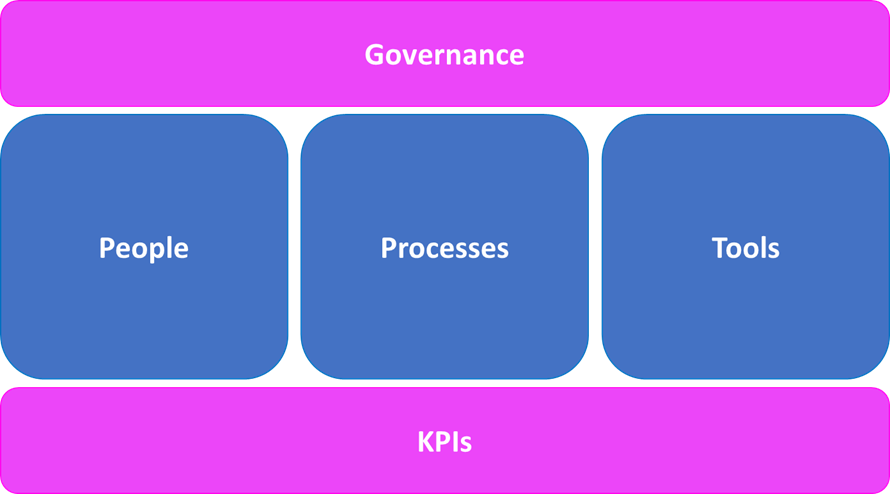A cloud operating model is a framework that outlines how an organization manages and operates its cloud infrastructure, applications, and services. It encompasses the processes, roles, technologies, and policies required to effectively deploy, manage, and optimize cloud resources.
Key components of a cloud operating model include:

1. Governance and Complaince:
Governance here plays a key role to ensure that all the applications in cloud abide by a set of standard policies which are aligned to the vision of the programme. To establish governance, organizations need to lay down various layers:
- Regulatory Compliance
- Security Policies
- Data Protection Standards
- Risk Management
2. People:
Skills and expertise
Roles and responsibilities
Training and development
3. Processes:
Tracking and optimizing cloud expenditures to achieve cost efficiency. This involves budgeting, forecasting, and implementing cost-saving measures like rightsizing and using reserved instances.
4. Tools:
Designing a scalable, resilient, and secure cloud architecture. This includes selecting appropriate cloud services, designing for high availability, disaster recovery, and ensuring that the architecture aligns with business objectives.
5. KPIs:
Defining and automating operational processes for managing cloud resources. This includes continuous integration/continuous deployment (CI/CD) pipelines, infrastructure as code (IaC), monitoring, and incident response.
| Key Pillars | Processes | Tools | KPIs |
| Governance | 1. Establish governance frameworks: Define policies, standards, and guidelines for cloud usage. 2. Risk assessment: Identify and evaluate risks associated with cloud adoption. 3. Policy enforcement: Implement tools and processes to enforce governance policies. 4. Compliance monitoring: Regularly audit and monitor compliance with regulatory and internal policies. 5. Incident management: Establish protocols for handling security breaches and non-compliance incidents. | 1. Cloud security management (CSM) tools 2. Compliance management tools (e.g., AWS Config, Azure Policy) 3. Identity and access management (IAM) solutions (e.g., Okta, AWS IAM) 4. Audit and monitoring tools (e.g., Splunk, ELK Stack) | 1. Number of compliance violations 2. Time to resolve security incidents 3. Percentage of cloud resources compliant with policies 4. Frequency of governance reviews and audits |
| People | 1. Define roles and responsibilities: Clarify roles such as cloud architects, security engineers, DevOps engineers, and compliance officers. 2. Skills assessment: Evaluate the current skill set of the team and identify gaps. 3. Training programs: Develop and deliver training programs to bridge skill gaps. 4. Collaboration: Foster collaboration between development, operations, and security teams (DevSecOps). | 1. Learning management systems (LMS) (e.g., Coursera, Pluralsight) 2. Certification programs (e.g., AWS Certified Solutions Architect, Azure Certification) 3. Collaboration tools (e.g., Slack, Microsoft Teams) 4. HR and talent management systems (e.g., Workday, SAP SuccessFactors) | 1. Number of staff with cloud certifications 2. Training completion rates 3. Employee satisfaction and engagement scores 4. Skill gap reduction over time |
| Processes | 1. Define SOPs: Document standard operating procedures for cloud management. 2. Implement best practices: Adopt industry best practices for cloud architecture, security, and operations. 3. Workflow automation: Automate repetitive tasks and workflows to improve efficiency. 4. Continuous improvement: Regularly review and refine processes based on feedback and performance data. | 1. IT service management (ITSM) tools (e.g., ServiceNow, Jira Service Management) 2. Workflow automation tools (e.g., Ansible, Terraform) Process documentation tools (e.g., Confluence, SharePoint) 3. Continuous integration/continuous deployment (CI/CD) tools (e.g., Jenkins, GitLab CI/CD) | 1. Process compliance rate 2. Incident response time 3. Change success rate 4. Efficiency gains from automation |
| Tools | 1. Evaluate and select tools: Assess tools based on requirements, compatibility, and scalability. 2. Integrate tools: Ensure seamless integration of selected tools into the cloud environment. 3. Manage tools: Regularly update and maintain tools to ensure optimal performance. 4. Measure tool effectiveness: Evaluate the performance and impact of tools on cloud operations. | 1. Cloud management platforms (e.g., CloudHealth, CloudCheckr) 2. Security tools (e.g., Palo Alto Networks, Check Point) 3. Monitoring and observability tools (e.g., Datadog, New Relic) 4. Cost management tools (e.g., AWS Cost Explorer, Azure Cost Management) | 1. Tool utilization rate 2. Tool performance metrics (e.g., uptime, response time) 3. Return on investment (ROI) for tools 4. User satisfaction with tools |
| KPIs | 1. Define KPIs: Identify key metrics that align with business objectives and cloud strategy. 2. Collect data: Implement tools and processes to collect relevant data for KPIs. 3. Analyze data: Regularly analyze data to gain insights into cloud performance and identify areas for improvement. 4. Report findings: Share KPI reports with stakeholders to inform decision-making and strategy. | 1. Dashboard and reporting tools (e.g., Power BI, Tableau) 2. Monitoring and analytics tools (e.g., Grafana, CloudWatch) 3. Data visualization tools (e.g., Google Data Studio, Looker) 4. Business intelligence (BI) tools (e.g., Qlik, Domo) | 1. Cost efficiency (e.g., cost per user, cost per transaction) 2. Resource utilization (e.g., CPU, memory usage) 3. Service availability and uptime 4. Incident response and resolution times 5. User satisfaction and adoption rates |
By addressing these elements, a cloud operating model helps organizations efficiently leverage cloud technologies to drive business growth, improve agility, and enhance operational efficiency.
